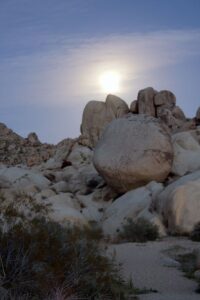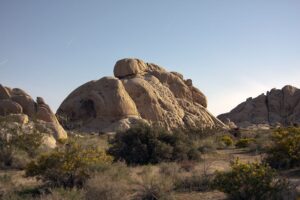Lunar Apogee
This weekend was a lunar perigee full moon. These don’t happen all that much together; perigee is the moon’s closest point to Earth in its orbit so the net result is an ever so slightly larger and therefore brighter moon. I decided to take advantage of this situation by driving to Joshua Tree National Park, a roughly 3 hour trek. I left the house around 12:30 PM and arrived at the Visitor’s Center at the northern edge of the park at 3:00 PM. A quick discussion with a ranger, a purchased entrance fee and off I went into the park. I drove on Geology Tour Rd and Queen Valley Rd (both unimproved) before deciding on hanging out along a stretch of Geology Tour Rd. The ranger assured me that area would very dark and pretty much devoid of people.
I stopped at the very southern corner of Geology Tour Rd and shot this panorama looking north of Pleasant Valley.
 Setting Up and Weather
Setting Up and Weather
I found a good turn-off next to the road and set up. The moon rose above the rock formations and I took this image.

The full moon is behind a cloud. This was an ominous beginning; the clouds were coming in from the coast in front of the rain storm that hit us the next day. The clouds cut down the light available and made exposure estimation that much harder.
This was a multiple-minute exposure of a granite rock outcropping just off the road.

Eventually the clouds became so heavy I had to abandon the activity; the light was less than half what it was at the beginning of the evening.
Lessons learned:
1. Bring extra batteries. I went through a double battery pack in 3 hours of shooting. The long exposures really drain the batteries.
2. Next time I’ll get a hotel room out there and work all night instead of feeling like I had to get done by a certain time so I could safely drive home.
3. Give more time for location scouting.
4. Improve my autofocus management technique.